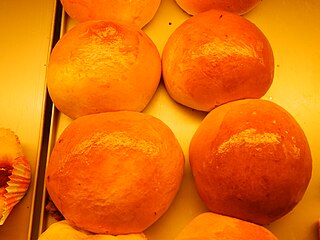
A macaroon is a small cake or biscuit, typically made from ground almonds, coconut or other nuts, with sugar and sometimes flavourings, food colouring, glacé cherries, jam or a chocolate coating; or a combination of these or other ingredients. Some recipes use sweetened condensed milk. Macaroons are sometimes baked on edible rice paper placed on a baking tray.

Coconut jam, also known as kaya jam, is a sweet spread made from a base of coconut milk, eggs and sugar. It is popular throughout Southeast Asia.

Filipino cuisine is composed of the cuisines of more than a hundred distinct ethnolinguistic groups found throughout the Philippine archipelago. A majority of mainstream Filipino dishes that compose Filipino cuisine are from the food traditions of various ethnolinguistic groups and tribes of the archipelago, including the Ilocano, Pangasinan, Kapampangan, Tagalog, Bicolano, Visayan, Chavacano and Maranao ethnolinguistic groups. The style of food making and preparation, and the dishes associated with them, have evolved over many centuries from their Austronesian origins to a mixed cuisine of Chinese, Spanish and American influences, in line with the major waves of influence that had enriched the cultures of the archipelago, as well as others adapted to indigenous ingredients and the local palate.

Torta is a culinary term that can, depending on the cuisine, refer to cakes, pies, flatbreads, sandwiches, or omelettes.
Venezuelan cuisine is influenced by its European, West African, and indigenous traditions. Venezuelan cuisine varies greatly from one region to another. Food staples include corn, rice, plantains, yams, beans and several meats. Potatoes, tomatoes, onions, eggplants, squashes, spinach and zucchini are also common side dishes in the Venezuelan diet. Ají dulce and papelón are found in most recipes. Worcestershire sauce is also used frequently in stews. Venezuela is also known for having a large variety of white cheese, usually named by geographical region.

Colombian cuisine is a compound of the culinary traditions of the six main regions within the country. Colombian cuisine varies regionally and is particularly influenced by Indigenous Colombian, Spanish, and African cuisines, with slight Arab influence in some regions. Furthermore, being one of the most biodiverse countries in the world, Colombia has one of the widest variety of available ingredients depending on the region.

Pandesal, , is a common bread roll in the Philippines. It is made of flour, yeast, sugar, oil, and salt.
Dominican cuisine is made up of Spanish, indigenous Taíno, Middle-Eastern and African influences. Many Middle-Eastern dishes have been adopted into Dominican cuisine, such as the "Quipe" that comes from the Lebanese kibbeh.

Ginataan, alternatively spelled guinataan, is a Filipino term which refers to food cooked with gatâ. Literally translated, ginataan means "done with coconut milk". Due to the general nature of the term, it can refer to a number of different dishes, each called ginataan, but distinct from one another.

Bukayo is a Filipino dessert made from sweetened coconut strips. It is traditionally made by simmering strips or shredded bits of young, gelatinous coconut (buko) in water and sinuklob, which is sugarcane muscovado sugar melted into a chewy caramel-like consistency. Dryer versions of bukayo with a crumbly texture are known as bocarillo. Bukayo can be eaten on its own, usually rolled into little balls. But they can also be used as garnishing and fillings for other desserts, most notably for pan de coco and sinudlan empanada.

Cassava cake is a traditional Filipino moist cake made from grated cassava, coconut milk, and condensed milk with a custard layer on top. It is a very popular dish in the Philippines, where it is commonly eaten for merienda. It is also served during gatherings and special occasions.

Samalamig, also known as palamig, refers to various traditional Filipino sweet chilled beverages that usually include jelly-like ingredients. They can come in various flavors. They are commonly sold by street vendors as refreshments. Typical ingredients of the drinks include gulaman (agar), sago pearls, kaong, tapioca pearls, nata de coco, and coconut. They are usually anglicized as pearl coolers or pearl and jelly coolers.

Ube crinkles, also known as purple yam crinkles, are Filipino cookies made from purple yam, flour, eggs, baking powder, butter, and sugar. They are characteristically deep purple in color and are typically rolled in powdered sugar or glazed. They have a crunchy exterior and a soft chewy center.

Buko salad, usually anglicized as young coconut salad, is a Filipino fruit salad dessert made from strips of fresh young coconut (buko) with sweetened milk or cream and various other ingredients. It is one of the most popular and ubiquitous Filipino desserts served during celebrations and fiestas.
Pan de coco, literally "coconut bread" in Spanish, is a dense, cake-like bread from the Garifuna people of the Caribbean coast located in Honduras. It's dough features coconut milk as its main ingredient, and typically does not incorporate eggs or milk. Despite its coconut content, the bread is not sweet and is often served with savory foods, like stews and soups. Many variations of Pan de Coco can be found in various other Latin American countries.

Asado rolls, also called asado buns or baked siopao, is a Filipino bread roll filled with savory-sweet pork asado. It is similar to the asado siopao except it is baked and uses all-purpose flour instead of rice flour. The top can either be covered with an egg wash, bread crumbs, or sprinkled with sesame seeds.
Pan de siosa is a Filipino pull-apart bread originating from the Visayas Islands of the Philippines. They characteristically have a very soft texture and are baked stuck together. They can be eaten plain with savory meat or soup dishes, or as a dessert brushed with a generous amount of butter and sprinkled with sugar and grated cheese. In Bacolod, they can also uniquely be toasted on a skewer and brushed with oil, margarine, or banana ketchup; and then eaten paired with inihaw dishes.














